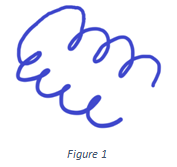This set of Protein Engineering online test focuses on “Structure Function Relationships – HTH Motif and Homeodomain”.
1. Considering the specificity of the protein-DNA interaction in the case of regulatory proteins it can be concluded that there is a particular amino acid-base code.
a) True
b) False
View Answer
Explanation: The above statement is false. Examination of the structure of many DNA-binding proteins has shown that a protein can recognize each base pair in more than one way. This leads to the conclusion that there is no simple amino acid-base code.
2. Which of the following proteins have discrete DNA-binding domains?
a) Excretory proteins
b) Plasma membrane proteins
c) Catalytic proteins
d) Regulatory proteins
View Answer
Explanation: Regulatory proteins have discrete DNA-binding domains. They regulate the expression of genes in a cell. They bind to specific DNA sequences. Excretory proteins, plasma membrane proteins, and catalytic proteins do not have discrete DNA-binding domains.
3. Which of the following interactions majorly imparts specificity to most of the protein-DNA contacts?
a) Hydrophobic interaction
b) Covalent interactions
c) Disulfide bonds
d) Hydrogen bonds
View Answer
Explanation: Hydrogen bonds majorly imparts specificity to most of the protein-DNA contacts. The discrimination between base pairs and hydrogen bond donors and acceptor groups occur in the major groove of DNA.
4. Which of the following is a feature of a lac repressor?
a) It is a dimer
b) It is a trimer
c) It is a monomer
d) It is a tetramer
View Answer
Explanation: The lac repressor is a tetramer. In this tetramer, two dimers are tethered together. This tetrameric structure of the lac repressor is an exception, as in most of the regulatory proteins the DNA-binding domain occurs in dimers.
5. Which among the following is not a DNA-binding motif?
a) H-T-H
b) Zinc fingers
c) Homeodomain
d) Homeobox
View Answer
Explanation: Homeobox is not a DNA-binding motif. The DNA sequence that encodes homeodomain is known as the homeobox. H-T-H, zinc fingers, and homeodomain are DNA-binding motifs.
6. Which DNA-binding motif has two short helical segments separated by a turn?
a) H-L-H
b) Leucine zipper
c) Zinc fingers
d) H-T-H
View Answer
Explanation: The H-T-H DNA-binding motif has two short helical segments separated by a turn. Leucine zipper and Zinc fingers do not have two helical segments. H-L-H has two short helical segments but they are separated by a loop.
7. What is the average length of the H-T-H motif?
a) 30 amino acid residues
b) 50 amino acid residues
c) 100 amino acid residues
d) 20 amino acid residues
View Answer
Explanation: The average length of the H-T-H motif is 20 amino acid residues. It contains two α-helices separated by a beta-turn. The length of this beta-turn is usually very short.
8. What is the average length of the α-helical segments in the H-T-H motif?
a) 13 – 15 amino acid residues
b) 11 – 19 amino acid residues
c) 10 – 15 amino acid residues
d) 7 – 9 amino acid residues
View Answer
Explanation: The average length of the α-helical segments in the H-T-H motif is about 7 – 9 amino acid residues. The H-T-H motif contains two short-helices. It is present in the DNA-binding domain of many bacterial regulatory proteins.
9. The H-T-H structure is inherently very stable.
a) True
b) False
View Answer
Explanation: The above statement is false. The structure is not generally stable by itself; it is simply the reactive portion of a somewhat larger DNA-binding domain. Hence, the H-T-H structure is not inherently stable.
10. From the H-T-H motif, only one of the two α-helical segments is called the recognition helix.
a) False
b) True
View Answer
Explanation: The above statement is true. From the H-T-H motif, only one of the two α-helical segments is called the recognition helix, because it usually contains many of the amino acids that interact with the DNA in a sequence-specific manner.
11. The lac repressor has which of the following DNA-binding motifs?
a) Leucine zippers
b) Zinc fingers
c) Homeodomain
d) H-T-H motif
View Answer
Explanation: The lac repressor has H-T-H DNA-binding motifs. The lac repressor is a tetramer. It contains two dimers tethered together. Hence, in total it has 4 H-T-H DNA-binding motifs.
12. What are the genes that regulate the development of body patterns called?
a) Developmental genes
b) Growth genes
c) Activator genes
d) Homeotic genes
View Answer
Explanation: The genes that regulate the development of body patterns are called homeotic genes. Homeodomain was first discovered in homeotic genes. Mutations in the homeotic genes are lethal.
13. Which of the following DNA-binding motif functions as transcriptional regulators, especially during eukaryotic development?
a) Zinc fingers
b) Leucine zippers
c) H-T-H motif
d) Homeodomain
View Answer
Explanation: Homeodomain is the DNA-binding motif that functions as transcriptional regulators, especially during eukaryotic development. These domains are highly conserved and have now been identified in proteins from a wide variety of organisms.
14. What is the DNA sequence that encodes the homeodomain known as?
a) Zinc fingers
b) H-T-H motifs
c) Leucine zippers
d) Homeobox
View Answer
Explanation: Homeobox is the DNA sequence that encodes the homeodomain. The DNA binding segment of homeodomain is related to the helix-turn-helix motif.
15. Which of the following motif is depicted in the figure below?

a) Homeobox
b) Leucine zippers
c) Zinc fingers
d) H-T-H motif
View Answer
Explanation: The H-T-H motif is depicted in the figure above. It contains two α-helical segments which are separated by a beta-turn. These H-T-H motifs are commonly found in regulatory proteins.
Sanfoundry Global Education & Learning Series – Protein Engineering.
To practice all areas of Protein Engineering for online tests, here is complete set of 1000+ Multiple Choice Questions and Answers.
If you find a mistake in question / option / answer, kindly take a screenshot and email to [email protected]
- Practice Biotechnology MCQs
- Apply for Biotechnology Internship
- Check Protein Engineering Books
- Check Biotechnology Books
